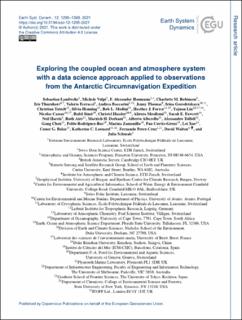| dc.description.abstract | The Southern Ocean is a critical component of Earth's climate system, but its remoteness makes it challenging to develop a holistic understanding of its processes from the small scale to the large scale. As a result, our knowledge of this vast region remains largely incomplete. The Antarctic Circumnavigation Expedition (ACE, austral summer 2016/2017) surveyed a large number of variables describing the state of the ocean and the atmosphere, the freshwater cycle, atmospheric chemistry, and ocean biogeochemistry and microbiology. This circumpolar cruise included visits to 12 remote islands, the marginal ice zone, and the Antarctic coast. Here, we use 111 of the observed variables to study the latitudinal gradients, seasonality, shorter-term variations, geographic setting of environmental processes, and interactions between them over the duration of 90 d. To reduce the dimensionality and complexity of the dataset and make the relations between variables interpretable we applied an unsupervised machine learning method, the sparse principal component analysis (sPCA), which describes environmental processes through 14 latent variables. To derive a robust statistical perspective on these processes and to estimate the uncertainty in the sPCA decomposition, we have developed a bootstrap approach. Our results provide a proof of concept that sPCA with uncertainty analysis is able to identify temporal patterns from diurnal to seasonal cycles, as well as geographical gradients and “hotspots” of interaction between environmental compartments. While confirming many well known processes, our analysis provides novel insights into the Southern Ocean water cycle (freshwater fluxes), trace gases (interplay between seasonality, sources, and sinks), and microbial communities (nutrient limitation and island mass effects at the largest scale ever reported). More specifically, we identify the important role of the oceanic circulations, frontal zones, and islands in shaping the nutrient availability that controls biological community composition and productivity; the fact that sea ice controls sea water salinity, dampens the wave field, and is associated with increased phytoplankton growth and net community productivity possibly due to iron fertilisation and reduced light limitation; and the clear regional patterns of aerosol characteristics that have emerged, stressing the role of the sea state, atmospheric chemical processing, and source processes near hotspots for the availability of cloud condensation nuclei and hence cloud formation. A set of key variables and their combinations, such as the difference between the air and sea surface temperature, atmospheric pressure, sea surface height, geostrophic currents, upper-ocean layer light intensity, surface wind speed and relative humidity played an important role in our analysis, highlighting the necessity for Earth system models to represent them adequately. In conclusion, our study highlights the use of sPCA to identify key ocean–atmosphere interactions across physical, chemical, and biological processes and their associated spatio-temporal scales. It thereby fills an important gap between simple correlation analyses and complex Earth system models. The sPCA processing code is available as open-access from the following link: https://renkulab.io/gitlab/ACE-ASAID/spca-decomposition (last access: 29 March 2021). As we show here, it can be used for an exploration of environmental data that is less prone to cognitive biases (and confirmation biases in particular) compared to traditional regression analysis that might be affected by the underlying research question. | en_US |

